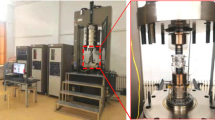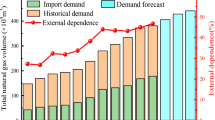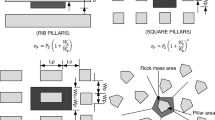Abstract
The failure of pillars between bedded salt cavern gas storages can be seen as processes that the deformations of pillars convert from continuous gradual change system to catastrophe state, which are typical nonlinear catastrophe problems. In the paper, the cusp catastrophe model is proposed to obtain the stability factors of pillars. It can overcome the shortages of traditional strength reduction finite element method (SR FEM) and greatly improve the accuracy of stability factors obtained by numerical simulations. The influences of cavern depth, gas pressure, pillar width, and time on the stability factors are studied. Y-1 and Y-2 salt cavern gas storages, located at Jiangsu province of China, were simulated as examples. The stability factors of pillars between Y-1 and Y-2 were evaluated, and the running parameters were recommended to ensure the pillars stability. The results showed that the cusp catastrophe model has high practicability and can precisely predict the stability factors. The stability factors are equidirectional with the increase of gas pressure and pillar width, but reverse to the increase of cavern depth and time. The stability factors of pillars between Y-1 and Y-2 are small for narrow widths, which are influenced greatly by gas pressure, time, pressure difference, and gas production rate. In order to ensure the safety of pillars, the lowest gas pressure, safe running time, max. pressure difference and max. gas production rate of Y-1 and Y-2 were recommended as 7 MPa, 5 years, 3 MPa, and 0.50 MPa/d, respectively.
Similar content being viewed by others
References
Eickemeier R, Paar W A, Heusermann S. Hengelo brine field revisited “determination of allowable loading of pillars”. In: Proceedings of 2004 Technical Meeting Berlin, Germany, 2004
Sambeek L L van. Stability analysis of inactive cavern clusters: Hengelo brinefield. Respec topical report RSI-1793, Revision 2, RESPEC, 2004
Urai J L, Bekendam R F. Pillar deformation induced subsidence, Stage 2. GeoControl Report S00612, RESPEC, 2006
Bekendam R F, Urai J L. Pillar deformation-induced surface subsidence in the Hengelo brine field, the Netherlands. The Mechanical Behavior of Salt — Understanding of THMC Processes in Salt, Hannover, Germany, 2007. 369–376
Bekendam R F, Oldenziel C E, Paar W A. Subsidence potential of the Hengelo brine field (Part I)—physico-chemical deterioration and mechanical failure of salt-cavern roof layers. In: Proceedings of the SMRI fall meeting, San Antonio, 2000. 103–117
Wilson A H. An hypothesis concerning pillar stability. The Mining Engineer (GB), 1972, 131: 409–417
Wilson A H. The effect of yield zones on the control of ground. In: Sixth International Strata Control Conference, Banff, 1977
Wilson A H. Stress, stability in coal ridsides and pillars. In: Proceedings of the First Conference on Ground Control in Mining, 1981. 1–12
Waltham A C, Chorlton I G. Rock roof stability in the sandstone caves of Nottingham. Engineering Geology of Weak Rock. Balkema, Rotterdam, 1993: 489–492
Waltham A C, Cubby T J. Developments in Nottingham’s sandstone caves. Mercian Geologist, 1997, 14: 58–67
Waltham A C, Swift G M. Bearing capacity of rock over mined cavities in Nottingham. Eng Geology, 2004, 75: 15–31
Zhang L M, Zheng Y R, Wang Z Q. Application of strength reduction finite element method to road tunnels (in Chinese). Rock Soil Mech, 2007, 28: 97–101
Zheng Y R, Tang X S, Zhao S, et al. Application of strength reduction FEM in fording slope (in Chinese). Hydrosci Eng, 2009, 4: 1–10
Huang M S, Jia C Q. Strength reduction FEM in stability analysis of soil slopes subjected to transient unsaturated seepage. Computers Geotech, 2009, 36: 93–101
Joanna L G, Adrian R M, Cole M D. Strength reduction factors for near-fault forward-directivity ground motions. Eng Struct, 2010, 32: 273–285
Zhao S Y, Zheng Y R, Shi W M, et al. Analysis on safety factor of slope by strength reduction FEM (in Chinese). Chin J Geotech Eng, 2002, 24: 343–346
Zheng Y R, Xiao Q, Ye H L, et al. Study of tunnel stability analysis with seismic load (in Chinese). Chin J Rock Mech Eng, 2010, 29: 1081–1088
Devries K L, Callahan G D, Mellegard K D. Numerical simulations of natural gas storage caverns in bedded salt. The 40th U.S. Symposium on Rock Mechanics (USRMS): Rock Mechanics for Energy, Mineral and Infrastructure Development in the Northern Regions, Alaska, 2005
Qin S Q. Primary discussion on formation mechanism of dissipative structure in instability process of rock mass (in Chinese). Chin J Rock Mech Eng, 2000, 19: 265–269
Bornyakov S A, Truskov V A, Cheremnykh A V. Dissipative structures in fault zones and their diagnostic criteria (from physical modeling data). Russian Geology Geophys, 2008, 49: 138–143
Fu C H, Chen S H. Study on instability criteria of surrounding rock of underground engineering cavern based on catastrophe theory (in Chinese). Rock Soil Mech, 2008, 29: 167–172
Yang K, Wang T X, Ma Z T. Application of cusp catastrophe theory to reliability analysis of slopes in open-pit mines (in Chinese). Mining SciTech, 2010, 20: 71–75
Leynaud D, Sultan N. 3-D slope stability analysis: a probability approach applied to the nice slope (SE France). Marine Geology, 2010, 269: 89–106
Zhou C Y, Chen H, Zhu F X. Research on nonlinear dynamic warning for high slopes based on progressive evolution process (in Chinese). ChinJ Rock Mech Eng, 2008, 27: 818–824
Kemal H, Hasan B B, Alemdar B, et al. Nonlinear analysis of rock-fill dams to non-stationary excitation by the stochastic Wilson-θ method. Appl Math Computation, 2007, 194: 333–345
Pan Y, Zhang Y, Wang Z Q. Catastrophe theoretical analysis of disintegrated outburst of a single coal shell in coal-gas outburst (in Chinese). Rock Soil Mech, 2009, 30: 595–603
Yan C B, Xu G Y, Zuo Y J. Destabilization analysis of overlapping underground chambers induced by blasting vibration with catastrophe theory. Trans Nonferrous Metals Society China, 2006, 16: 735–740
Li X B, Zhou Z L, Lok T S, et al. Innovative testing technique of rock subjected to coupled static and dynamic loads. IntJ Rock Mech Mining Sci, 2008, 45: 739–748
Kenneth H, John J C, John F O. Legacies of catastrophic rock slope failures in mountain landscapes. Earth-Science Rev, 2008, 87: 1–38
Wang T T, Yan X Z, Yang X J, et al. Dynamic subsidence prediction of ground surface above salt cavern gas storage considering the creep of rock salt. Sci China Tech Sci, 2010, 53: 3197–3202
Gu C S, Wu H Z, Su H Z. Research on stability of the accumulated rock-s oil body of reservoir bank under rainfall condition. Sci China Ser E-Tech Sci, 2009, 52: 2528–2535
Casti J. Catastrophe theory and the problem of stellar collapse. Technical Report, International Institute for Applied Systems Analysis, Laxenburg, Austria, 1974
Qin S Q, Jiao J J, Wang S J, et al. A nonlinear catastrophe model of instability of planar-slip slope and chaotic dynamical mechanisms of its evolutionary process. Int J Solids Struct, 2001, 38: 8093–8109
Xu C H, Pen Q W. Criterion of entropy catastrophe of stability of surrounding rock (in Chinese). Rock Soil Mech, 2004, 25: 34–40
Yang C H, Li Y P, Chen F. Bedded Rock Salt Mechanics and Engineering (in Chinese). Beijing: Science Press, 2009. 103–179, 188
Steven R S, Brian L E. Technical Report, 3-D Cavern Enlargement Analyses. Sandia National Laboratories, 2001
Author information
Authors and Affiliations
Corresponding author
Rights and permissions
About this article
Cite this article
Wang, T., Yan, X., Yang, H. et al. Stability analysis of the pillars between bedded salt cavern gas storages by cusp catastrophe model. Sci. China Technol. Sci. 54, 1615–1623 (2011). https://doi.org/10.1007/s11431-011-4401-5
Received:
Accepted:
Published:
Issue Date:
DOI: https://doi.org/10.1007/s11431-011-4401-5




